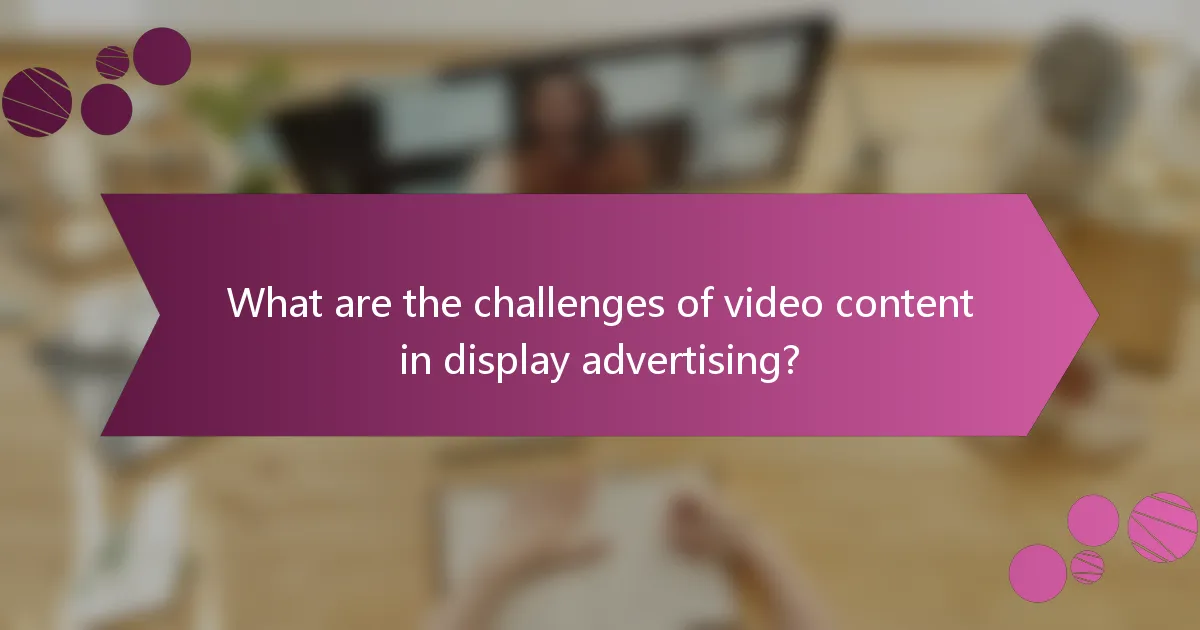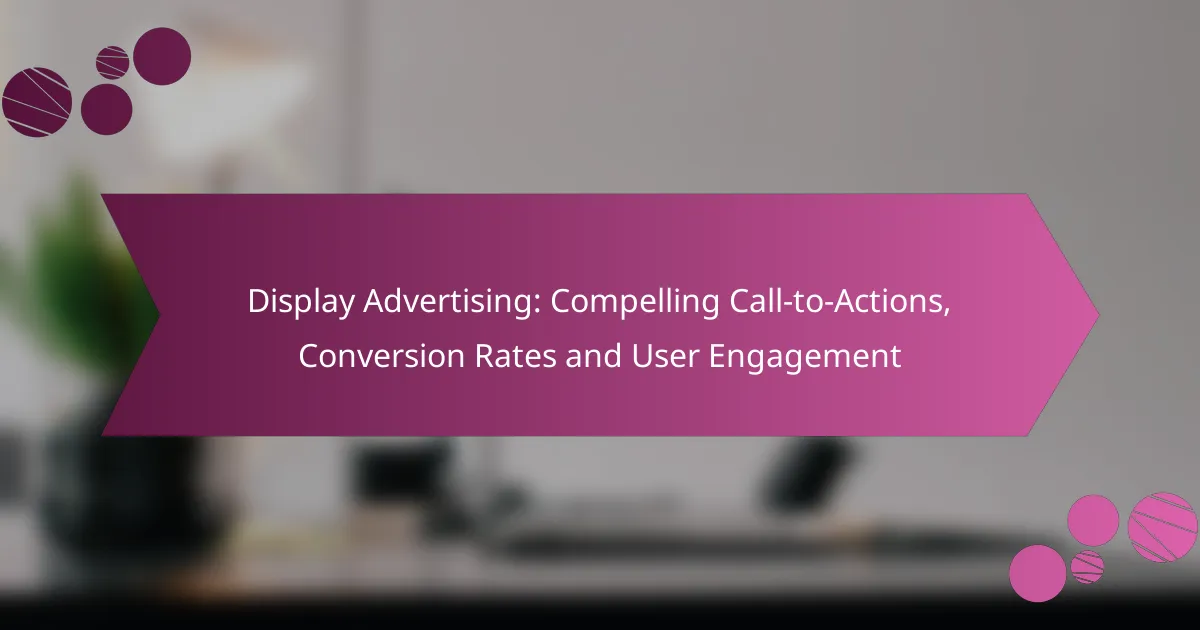Video content has emerged as a powerful tool in display advertising, significantly enhancing viewer engagement by capturing attention and delivering messages more effectively than traditional formats. By integrating short-form clips, interactive elements, and user-generated content, advertisers can create compelling ads that encourage interaction and improve performance across various platforms like Google Display Network, Facebook Ads, and YouTube Ads.

How does video content enhance display advertising engagement?
Video content significantly boosts engagement in display advertising by capturing attention and conveying messages more effectively than static images or text. It encourages viewers to interact with ads, leading to better overall performance.
Increased viewer retention
Video content tends to hold viewers’ attention longer than traditional display ads. This increased retention is crucial, as ads that engage users for extended periods are more likely to leave a lasting impression. For instance, videos that are 15 to 30 seconds long can effectively convey a brand message without losing viewer interest.
To maximize viewer retention, consider using compelling visuals and concise messaging. Engaging storytelling elements can also help maintain interest throughout the video.
Higher click-through rates
Incorporating video into display ads can lead to significantly higher click-through rates (CTR). Studies have shown that video ads can achieve CTRs that are several times higher than those of static ads. This increase is often attributed to the dynamic nature of video, which can entice viewers to take action.
To improve CTR, ensure that the video is relevant to the target audience and includes a clear call to action. Testing different video formats and lengths can also help identify what resonates best with viewers.
Improved brand recall
Video content enhances brand recall by creating memorable experiences for viewers. When consumers engage with video ads, they are more likely to remember the brand and its message compared to traditional ads. This is particularly important in competitive markets where brand differentiation is key.
Utilizing unique visuals, catchy music, and storytelling can strengthen brand recall. Brands should aim to create videos that evoke emotions or tell a story that resonates with their audience.
Enhanced storytelling capabilities
Video allows brands to tell their stories in a more engaging and immersive way. Through visuals, sound, and narrative, brands can convey complex messages and emotions that resonate with viewers. This storytelling capability is particularly effective in building a connection with the audience.
To leverage storytelling in video ads, focus on creating a narrative arc that includes a beginning, middle, and end. Incorporating relatable characters or scenarios can also enhance viewer engagement and connection to the brand.

What are effective strategies for integrating video into display ads?
Effective strategies for integrating video into display ads include using short-form video clips, incorporating interactive elements, and leveraging user-generated content. These approaches enhance viewer engagement and can significantly boost ad performance.
Using short-form video clips
Short-form video clips, typically lasting between 6 to 30 seconds, are ideal for capturing attention quickly. They should convey the core message or value proposition in a concise manner, making them perfect for platforms like social media and mobile devices.
When creating short-form videos, focus on high-quality visuals and clear audio. Use captivating thumbnails and compelling calls to action to encourage viewers to engage further with your brand. Testing different formats can help identify what resonates best with your audience.
Incorporating interactive elements
Interactive elements in video ads, such as clickable buttons or polls, can significantly enhance viewer engagement. These features encourage users to participate actively rather than passively consuming content, leading to higher retention rates.
Consider integrating features like quizzes or product showcases that allow users to explore options directly within the ad. Ensure that the interactive elements are intuitive and seamlessly integrated into the video to avoid disrupting the viewing experience.
Leveraging user-generated content
User-generated content (UGC) can add authenticity and relatability to display ads. By showcasing real customers using your product, you create a sense of community and trust that resonates with potential buyers.
Encourage customers to share their experiences through video submissions, and select the best clips for your ads. This not only provides fresh content but also fosters brand loyalty. Always obtain permission before using UGC in your campaigns to respect copyright and privacy rights.

Which platforms are best for video display advertising?
The best platforms for video display advertising include Google Display Network, Facebook Ads, and YouTube Ads. Each platform offers unique features and audience targeting options that can enhance engagement and drive conversions.
Google Display Network
The Google Display Network (GDN) allows advertisers to place video ads on a vast array of websites and apps. It reaches over two million websites, making it an excellent choice for broad audience targeting.
When using GDN, consider utilizing responsive display ads that automatically adjust to fit various ad spaces. This flexibility can improve visibility and engagement.
To maximize effectiveness, focus on creating visually appealing video content that captures attention within the first few seconds. Aim for concise messaging to ensure viewers remain engaged.
Facebook Ads
Facebook Ads provide robust targeting options for video display advertising, allowing brands to reach specific demographics based on interests, behaviors, and location. This platform is particularly effective for engaging users in a social context.
Utilize Facebook’s video ad formats, such as in-stream ads or Stories, to capture attention quickly. Keep videos short—ideally under 15 seconds—to maintain viewer interest and encourage shares.
Regularly analyze ad performance metrics to refine your strategy. Look for engagement rates and adjust your content based on what resonates with your audience.
YouTube Ads
YouTube Ads are a powerful tool for video display advertising, given the platform’s extensive reach and user engagement. With billions of users, YouTube offers various ad formats, including skippable and non-skippable ads.
When creating YouTube ads, focus on storytelling to captivate viewers. The first few seconds are crucial, so make sure to deliver your key message quickly.
Consider using YouTube’s targeting options, such as keyword targeting or custom audiences, to reach the right viewers. Monitor performance analytics to optimize your campaigns and improve ROI.

What metrics should be tracked for video display ad performance?
To effectively evaluate video display ad performance, focus on key metrics such as viewability rates, engagement rates, and conversion rates. These metrics provide insights into how well your ads are being seen, interacted with, and ultimately driving desired actions.
Viewability rates
Viewability rates measure the percentage of your video ads that are actually seen by users. According to industry standards, a video ad is considered viewable if at least 50% of its pixels are in view for a minimum of two seconds. Tracking this metric helps ensure that your ad spend is directed towards placements that genuinely reach your audience.
To improve viewability rates, consider optimizing ad placements on high-traffic websites and using formats that encourage visibility, such as in-stream ads. Regularly monitor and adjust your strategy based on performance data to maximize the effectiveness of your campaigns.
Engagement rates
Engagement rates reflect how users interact with your video ads, including actions like clicks, shares, and comments. A higher engagement rate indicates that your content resonates with viewers, which can lead to increased brand awareness and loyalty. Aim for engagement rates in the range of 5-15% for effective video campaigns.
To boost engagement, create compelling and relevant content that encourages interaction. Use clear calls-to-action and consider incorporating interactive elements, such as polls or quizzes, to enhance viewer participation and interest.
Conversion rates
Conversion rates measure the percentage of viewers who take a desired action after watching your video ad, such as making a purchase or signing up for a newsletter. A good conversion rate typically falls between 1-5%, depending on the industry and campaign goals. This metric is crucial for assessing the return on investment of your video advertising efforts.
To improve conversion rates, ensure that your video content aligns with your landing pages and offers a seamless user experience. Test different video lengths and messaging to determine what drives the highest conversions, and continuously refine your approach based on analytics and feedback.

How can brands optimize video content for different audiences?
Brands can optimize video content by tailoring their messaging and format to resonate with specific audience segments. Understanding audience preferences and behaviors is crucial for creating engaging video ads that drive higher engagement and conversion rates.
Tailoring content for mobile users
To effectively reach mobile users, brands should create short, visually engaging videos that load quickly and are easy to view on smaller screens. Consider using vertical or square formats, as these are more suitable for mobile viewing and can capture attention more effectively.
Incorporating captions is also essential, as many users watch videos without sound. Aim for videos that are under 30 seconds to maintain viewer interest and encourage shares on social media platforms.
Segmenting audiences by demographics
Segmenting audiences by demographics allows brands to create targeted video content that speaks directly to specific groups, such as age, gender, or location. This approach increases relevance and can lead to higher engagement rates.
For instance, younger audiences may prefer fast-paced, humorous content, while older demographics might appreciate informative and straightforward messaging. Tailoring the tone and style of videos to match the preferences of each demographic can enhance viewer connection.
Utilizing A/B testing
A/B testing is a valuable method for optimizing video content by comparing different versions to see which performs better. Brands can test various elements, such as video length, messaging, or visuals, to determine what resonates most with their audience.
Start by creating two versions of a video ad and running them simultaneously to a similar audience. Analyze metrics such as click-through rates and engagement levels to identify the more effective version, then refine your approach based on these insights for future campaigns.

What are the challenges of video content in display advertising?
Video content in display advertising faces several challenges, including high production costs and ad fatigue among viewers. These factors can significantly impact the effectiveness and return on investment of video campaigns.
High production costs
Creating high-quality video content often requires substantial financial investment. Costs can range from thousands to tens of thousands of dollars, depending on factors like scriptwriting, filming, and post-production. Brands must weigh these expenses against potential engagement and conversion rates.
To manage production costs, consider repurposing existing content or using user-generated videos. This approach can reduce expenses while still delivering engaging material to your audience.
Ad fatigue among viewers
Ad fatigue occurs when viewers become desensitized to repetitive video ads, leading to decreased engagement and effectiveness. This can happen quickly, especially if the same ad is shown multiple times across various platforms. Brands should monitor viewer response and rotate their video content regularly to maintain interest.
To combat ad fatigue, diversify your video content by experimenting with different formats, lengths, and messaging. Engaging storytelling and interactive elements can also help keep your audience’s attention and encourage them to interact with your ads.








